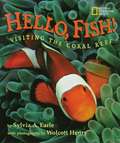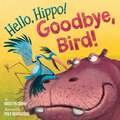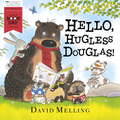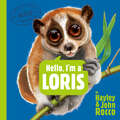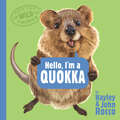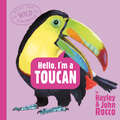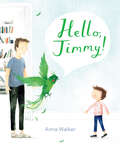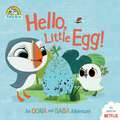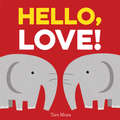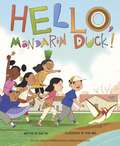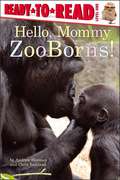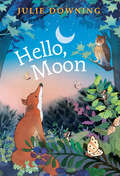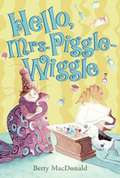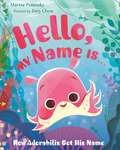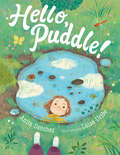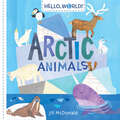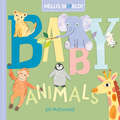- Table View
- List View
Hello, Crabby!: An Acorn Book (A Crabby Book #1)
by Jonathan FenskeCheck out this hilarious early reader series from Geisel Award Honoree Jonathan Fenske!Pick a book. Grow a Reader!This series is part of Scholastic's early reader line, Acorn, aimed at children who are learning to read. With easy-to-read text, a short-story format, plenty of humor, and full-color artwork on every page, these books will boost reading confidence and fluency. Acorn books plant a love of reading and help readers grow! Crabby is NOT happy. Sun is in Crabby's eyes. Salt is in Crabby's teeth. Sand is in Crabby's shell. Plankton tries again and again to cheer Crabby up -- with laugh-out-loud results! Will Crabby ever crack a smile? Or will Crabby always be crabby? With comic speech bubbles and full-color artwork throughout, Geisel Award Honoree Jonathan Fenske's early reader series is sure to be a hit with new readers!
Hello, First Grade
by Joanne RyderIt's a brand-new school year! Mrs. Lee's class is sure that first grade is the best once they meet Martha, the flop-eared bunny who is the class pet. When she's not in her special hiding places, Martha loves to say hello by hopping from student to student. So it's no surprise that Mrs. Lee's class wants to make Martha the star of a special school assembly. But when First Grade Day rolls around, Martha is nowhere to be found! Can the first grade class become first-rate detectives and find their flop-eared friend?" Pictures are described.
Hello, Fish!: Visiting the Coral Reef
by Sylvia A. EarleA famed oceanographer takes a tour of the Coral Reef and introduces such creatures as the damselfish, red lipped batfish, and brown goby.
Hello, Goodbye, I Love You The Story of Aloha A Guide Dog For The Blind
by Pamela Bauer MuellerOne boy, One dog, One dream. Life is not easy for 12 year old Diago Escobir. It was wonderful raising Aloha from puppyhood to 18 months, but now he must return her to the guide dog school for her formal training. Diego always new that Aloha was on loan to him, but letting her go is proving to be the hardest challenge of his young life. In this tender inspirational tale, based on the true life story of Aloha, Diego discovers the sweet and sad in life are often interwoven. The unconditional love and trust between Aloha and Diego will enable her to become the dog she was bred to be. In giving her up, Diego gains unexpected rewards.
Hello, Hippo! Goodbye, Bird!
by Kristyn CrowA hilarious picture book about a grumpy hippo, a persistent bird, and a delightful friendship! Bird wants to be Hippo&’s friend! Hippo wants to be left alone. Bird makes a great hat for Hippo. He tells hilarious hippo jokes. He keeps the bugs away (can you say lunch!?). Hippo wants Bird to GO AWAY. But then the sky gets darker. And darker. Thunder crashes all around. Maybe Hippo could use a friend?
Hello, Hugless Douglas!: World Book Day 2014 (Hugless Douglas #1)
by David MellingJoin Douglas for playtime, friend time and story time! How should the perfect day end for this hug-loving bear?Especially created for World Book Day 2014 and starring the much-loved Hugless Douglas, this charming story follows Douglas and his friends through a fun-filled day. Featuring a gallery of hugs, this is the ideal introduction to the world of Hugless Douglas for young children.
Hello, I'm a Loris (Meet the Wild Things)
by Hayley RoccoMeet the loris in this clever, funny, and informative nonfiction picture book, part of a series that focuses on endangered species.&“Wild, fun, and truly eye-opening, Meet the Wild Things gets us up close and personal with some of the world's most amazing creatures. With this series, Hayley and John Rocco are doing more than entertaining our kids—they&’re inspiring them to care about the future of our planet.&” —Brad Meltzer, bestselling author of the Ordinary People Change the World seriesDid you know lorises have night vision? That's why they have such big eyes. In fact, their eyes are so sensitive, bright light can be almost blinding to them.And did you know that lorises are primates, just like monkeys, apes, and humans? They are the only primates in the whole world that are venomous. If they feel scared or threatened, they can deliver a nasty, painful, and sometimes even deadly bite.But did you also know lorises are endangered and need our help? With humans chopping down rainforests and taking lorises from their homes to make them pets, these unique primates need our protection more than ever.Chock-full of amazing, kid-friendly facts and inviting artwork from the #1 New York Times bestselling and Caldecott Honoree illustrator of Blackout, the Meet the Wild Things series introduces young readers to endangered animals from around the globe, told from the points of view of the animals themselves.
Hello, I'm a Pangolin (Meet the Wild Things #2)
by Hayley RoccoSay hello to a pangolin, and learn all about this incredible endangered species—and why they need protecting—in this clever, funny, and informative nonfiction picture book, illustrated by a Caldecott Honoree.&“Wild, fun, and truly eye-opening, Meet the Wild Things gets us up close and personal with some of the world's most amazing creatures. With this series, Hayley and John Rocco are doing more than entertaining our kids—they&’re inspiring them to care about the future of our planet.&” —Brad Meltzer, bestselling author of the Ordinary People Change the World seriesDid you know pangolins are the only mammals with scales? Not even the teeth of a lion can break through their tough armor.And did you know pangolins have a super-sticky tongue as long as their entire body? (The better to eat 20,000 bugs a day with!)Chock-full of amazing, kid-friendly facts and inviting artwork from the #1 New York Times bestselling illustrator of Blackout, the Meet the Wild Things series introduces young readers to endangered animals from around the globe, told from the points of view of the animals themselves.
Hello, I'm a Quokka (Meet the Wild Things #3)
by Hayley RoccoA new book in the clever, funny, and informative nonfiction picture book series that focuses on endangered species.&“Wild, fun, and truly eye-opening, Meet the Wild Things gets us up close and personal with some of the world's most amazing creatures. With this series, Hayley and John Rocco are doing more than entertaining our kids—they&’re inspiring them to care about the future of our planet.&” —Brad Meltzer, bestselling author of the Ordinary People Change the World seriesMeet the quokka. Most of them live on a tiny island off of Western Australia. Like their relatives kangaroos and wallabies, they hop to get around and carry their babies in pouches.People say they are the happiest animal in the world. That's because they're very friendly, and their faces look like they are built for smiling--perfect for taking selfies with!Chock-full of amazing, kid-friendly facts and inviting artwork from the #1 New York Times bestselling, Caldecott Honoree illustrator of Blackout, the Meet the Wild Things series introduces young readers to endangered animals from around the globe, told from the points of view of the animals themselves.
Hello, I'm a Sloth (Meet the Wild Things #1)
by Hayley RoccoSay hello to a sloth, and learn all about this incredible endangered species—and why they need protecting—in this clever, funny, and informative nonfiction picture book, illustrated by a Caldecott Honoree.&“Wild, fun, and truly eye-opening, Meet the Wild Things gets us up close and personal with some of the world's most amazing creatures. With this series, Hayley and John Rocco are doing more than entertaining our kids—they&’re inspiring them to care about the future of our planet.&” —Brad Meltzer, bestselling author of the Ordinary People Change the World seriesDid you know sloths only poop once a week?Or that they can fall up to 100 feet without getting hurt?They have hundreds of bugs living on them, including a species of moths that only lives on sloths!And they move so slowly that algae grows on their fur, which—far from being gross—can actually help sloths by camouflaging them from predators.Chock-full of amazing, kid-friendly facts and inviting artwork from the #1 New York Times bestselling illustrator of Blackout, the Meet the Wild Things series introduces young readers to endangered animals from around the globe, told from the points of view of the animals themselves.
Hello, I'm a Toucan (Meet the Wild Things)
by Hayley RoccoMeet the toucan in this clever, funny, and informative nonfiction picture book, part of a series that focuses on endangered species.&“Wild, fun, and truly eye-opening, Meet the Wild Things gets us up close and personal with some of the world's most amazing creatures. With this series, Hayley and John Rocco are doing more than entertaining our kids—they&’re inspiring them to care about the future of our planet.&” —Brad Meltzer, bestselling author of the Ordinary People Change the World seriesDid you know a toucan's bill is four times the size of its head? But you might be surprised by how lightweight and strong it is.And did you know that toucans use their bills to keep cool when it's hot outside, by increasing blood flow from the rest of their body to maintain the perfect temperature? You can't get much cooler than that.But did you also know the toucan is endangered and needs our help? With humans chopping down rainforests and taking toucans from their homes to make them pets, these unique birds need our protection more than ever.Chock-full of amazing, kid-friendly facts and inviting artwork from the #1 New York Times bestselling, Caldecott Honoree illustrator of Blackout, the Meet the Wild Things series introduces young readers to endangered animals from around the globe, told from the points of view of the animals themselves.
Hello, I'm an Axolotl (Meet the Wild Things)
by Hayley RoccoMeet the axolotl in this clever, funny, and informative nonfiction picture book, part of a series that focuses on endangered species.&“Wild, fun, and truly eye-opening, Meet the Wild Things gets us up close and personal with some of the world's most amazing creatures. With this series, Hayley and John Rocco are doing more than entertaining our kids—they&’re inspiring them to care about the future of our planet.&” —Brad Meltzer, bestselling author of the Ordinary People Change the World seriesDid you know that axolotls have a superpower? They can regrow lost limbs, tails, and even parts of their hearts and brains!And they sparkle! That's because they have special cells in their bodies that reflect light like glitter. Pretty neat, huh?But did you also know the axolotl is endangered and needs our help? While there are about a million axolotls in tanks and aquariums around the world, there are fewer than 500 left in the wild.Chock-full of amazing, kid-friendly facts and inviting artwork from the #1 New York Times bestselling, Caldecott Honoree illustrator of Blackout, the Meet the Wild Things series introduces young readers to endangered animals from around the globe, told from the points of view of the animals themselves.
Hello, Jimmy!
by Anna WalkerA funny, noisy parrot comes into Jack's life and brings him closer to his dad in an unexpected and moving way in this gorgeous, emotionally resonant picture book from the creator of Florette.Jack loves staying at his dad&’s house. They have tacos and milkshakes, and make each other laugh. But lately Jack wonders if his dad is lonely when he isn&’t there. Then Jimmy arrives. Jimmy is loud and obnoxious, but Dad thinks he&’s clever and funny. Jack does not think he&’s clever or funny. And he&’s starting to wonder if Dad likes Jimmy better than he likes Jack. This beautifully written and illustrated book about the unconditional love a parent has for a child is both heartwarming and reassuring.
Hello, Little Egg!: An Oona and Baba Adventure (Puffin Rock)
by Penguin Young Readers LicensesWelcome to Puffin Rock—home to two young puffins, Oona and Baba. Join them on their adventures from the Netflix series, Puffin Rock.Oona, Baba, and Mossy are out playing when they discover a mysterious egg. It's a race against time as they try to find the parents before it hatches!
Hello, Love!
by Taro MiuraHow do animals show their love? By touching trunks, beaks, and noses! Toddlers will delight in adorable pairs of fish, ducklings, elephants, and monkeys as they splash, swim, dance, and swing, all while showing affection. Author-illustrator Taro Miura brings a playfulness and verve to this love-affirming board book, which culminates in the ultimate celebration of love: a child embraced by loving parents.
Hello, Love!
by Taro MiuraHow do animals show their love? By touching trunks, beaks, and noses! Toddlers will delight in adorable pairs of fish, ducklings, elephants, and monkeys as they splash, swim, dance, and swing, all while showing affection. Author-illustrator Taro Miura brings a playfulness and verve to this love-affirming board book, which culminates in the ultimate celebration of love: a child embraced by loving parents.
Hello, Mandarin Duck!
by Bao PhiTwins Hue and Hoa are excited for the May Day parade! While waiting at the park for the parade to begin, they spot a little duck who seems new to the neighborhood—and looks confused by the crowd and commotion. How can the twins help the duck get to the pond? Many friends from the neighborhood stop to say hello and offer suggestions. Teamwork, collective brainstorming, and the duck’s own inspiration finally help it reach its new home—with an entire community welcoming it with a parade! A celebration of a vibrant, multicultural neighborhood that warmly welcomes newcomers from near and far, this story also encourages communal problem-solving and offers a gentle reminder of the deportation fears many children and families face.
Hello, Mommy Zooborns!
by Andrew Bleiman Chris EastlandThis irresistibly endearing book of baby animal photos celebrates the bond between mother and child. What could be cuter than baby animals? Baby animals snuggling with their mamas! This adorable Level 1 Ready-to-Read story stars the lovable ZooBorns babies and their mothers, accompanied by text that's just right for beginning readers. This heartwarming tribute to motherhood is perfect for Mother's Day or any day of the year!
Hello, Moon
by Julie DowningThis perfect bedtime read-aloud describes that magical time, just as we're drifting off to sleep, when the moon the moon shines brightly and life emerges from the forest.Hello moon,Goodbye sun.Night is near,Day is done.When the sun goes down and most of us are getting ready for bed, the nighttime animals of the forest all wake up to the light of the moon. It calls to the them, from the slyest fox to the tiniest mouse, who feasts on leaves and fruit and scurries beneath the brush.A gentle rhyming text that will appeal to the youngest child is illustrated with soft and dreamy artwork in this perfect bedtime book in the tradition of Goodnight Moon.A Junior Library Guild Gold Standard Selection
Hello, Mrs. Piggle-Wiggle
by Betty MacdonaldFrom the book: Have you ever heard of Leadership Pills? Or Crybaby Tonic? Or Whisper Sticks? You won't find them in your corner drugstore. The only way to get these magical medicines is to call Mrs. PiggleWiggle. When Phillip Carmody turns into a Show-off, and Nicholas Semicolon acts like a Bully, and Harbin Quadrangle becomes a Slowpoke, their desperate parents pick up the phone and consult Mrs. Piggle-Wiggle. She has an old sea chest full of magic cures for children (left to her by her husband the pirate) and can supply the perfect remedy every time. Of course, although they're very efficient, Mrs. Piggle-Wiggle's cures have some comical consequences, too, making these remarkable adventures of her young friends a cheerful prescription for just about anyone. Other books by Betty MacDonald are available from Bookshare.
Hello, My Name Is . . .: How Adorabilis Got His Name
by Marisa PolanskyInspired by a true event! In the summer of 2015, an adorable new species of octopus was discovered on the ocean floor—this picture book story imagines how this cute creature got his name.Deep down in the water lives an octopus small enough to fit in the palm of your hand. But he doesn’t have a name! Anglerfish is named for his hook like an angler, Mimic Octopus for her ability to change shape and color, and Giant Squid is GIANT! But this little guy doesn’t have the same abilities as the other creatures. What could his name be? With Marisa Polansky's sweet text and Joey Chou's dynamic illustrations, Hello, My Name Is... imagines how the cutest creature in the sea got his name. The story includes a note from a scientist about the naming process and more information about Adorabilis.
Hello, Penguin! (National Geographic Kids Readers)
by Kathryn WilliamsMeet amazing penguins from all around the world! Young readers will learn about penguins big and small in this new pre-reader from National Geographic Kids. Through text features such as a vocabulary tree and wrap-up activity, kids will be introduced to vocabulary in concept groups – helping them make connections between words and expand their understanding of the world.
Hello, Puddle!
by Anita SanchezA nonfiction picture book exploring a deceptively simple but unexpectedly crucial resource for wildlife: puddles! This lyrical, gorgeously illustrated nonfiction picture book is perfect for young science learners and nature lovers.Hello, puddle! Who's here?A normal everyday puddle may not seem very special. But for a mother turtle, it might be the perfect place to lay her eggs. For a squirrel, it might be the only spot to cool off and get a drink when the sun is shining down in July. And for any child, it can be a window into the elegant, complex natural world right outside their window.With lush, playful illustrations and fun facts about the animals featured, Hello, Puddle! is a joyful celebration of the remarkable in the ordinary, and the importance of even the most humble places in fostering life.
Hello, World! Arctic Animals (Hello, World!)
by Jill McDonaldLearn from home and explore the world with these fun and easy board books!Toddlers can learn all about the lives of Arctic animals in the popular Hello, World! board book series, with easy-to-understand facts about how these incredible animals eat, sleep, camouflage, and stay warm in such a cold environment.Hello, World! is a series designed to introduce first nonfiction concepts to babies and toddlers. Told in clear and easy terms ("Siberian huskies curl into a tight ball to sleep") and featuring bright, cheerful illustrations, Hello, World! makes learning fun for young children. And each page offers helpful prompts for engaging with your child. It's a perfect way to bring science and nature into the busy world of a toddler, where learning never stops. Look for all the books in the Hello, World! series: • Solar System• Weather• Backyard Bugs• Birds• Dinosaurs• My Body• How Do Apples Grow?• Ocean Life• Moon Landing• Pets• Arctic Animals• Construction Site• Rainforest Animals• Planet Earth • Reptiles• Cars and Trucks • Music• Baby Animals• On the Farm• Garden Time• Planes and Other Flying Machines• Rocks and Minerals• Snow
Hello, World! Baby Animals (Hello, World!)
by Jill McDonaldLearn from home and explore the world with these fun and easy board books!Babies and toddlers will love spotting all the baby animals in this adorable and informative addition to the hit Hello, World! board book series. Children can learn all about fascinating wildlife families, with easy-to-understand facts and bright pictures of nature's babies.Hello, World! board books introduce first nonfiction concepts to babies and toddlers. Told in clear and easy words with simple facts ("A father emperor penguin balances an egg between its feet, keeping it safe and warm until it hatches") and featuring bright, cheerful illustrations, Hello, World! makes learning fun for young children. It's a perfect way to bring science into the busy world of a toddler, where learning never stops. Look for all the books in the Hello, World! series: • Solar System• Weather• Backyard Bugs• Birds• Dinosaurs• My Body• How Do Apples Grow?• Ocean Life• Moon Landing• Pets• Arctic Animals• Construction Site• Rainforest Animals• Planet Earth • Reptiles• Cars and Trucks • Music• Baby Animals• On the Farm• Garden Time• Planes and Other Flying Machines• Rocks and Minerals• Snow


